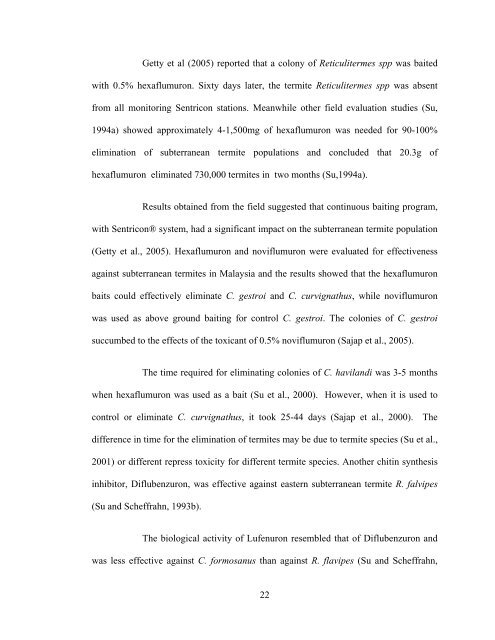SALAH SALEM OBAID GURBEL - ePrints@USM
SALAH SALEM OBAID GURBEL - ePrints@USM
SALAH SALEM OBAID GURBEL - ePrints@USM
You also want an ePaper? Increase the reach of your titles
YUMPU automatically turns print PDFs into web optimized ePapers that Google loves.
Getty et al (2005) reported that a colony of Reticulitermes spp was baited<br />
with 0.5% hexaflumuron. Sixty days later, the termite Reticulitermes spp was absent<br />
from all monitoring Sentricon stations. Meanwhile other field evaluation studies (Su,<br />
1994a) showed approximately 4-1,500mg of hexaflumuron was needed for 90-100%<br />
elimination of subterranean termite populations and concluded that 20.3g of<br />
hexaflumuron eliminated 730,000 termites in two months (Su,1994a).<br />
Results obtained from the field suggested that continuous baiting program,<br />
with Sentricon® system, had a significant impact on the subterranean termite population<br />
(Getty et al., 2005). Hexaflumuron and noviflumuron were evaluated for effectiveness<br />
against subterranean termites in Malaysia and the results showed that the hexaflumuron<br />
baits could effectively eliminate C. gestroi and C. curvignathus, while noviflumuron<br />
was used as above ground baiting for control C. gestroi. The colonies of C. gestroi<br />
succumbed to the effects of the toxicant of 0.5% noviflumuron (Sajap et al., 2005).<br />
The time required for eliminating colonies of C. havilandi was 3-5 months<br />
when hexaflumuron was used as a bait (Su et al., 2000). However, when it is used to<br />
control or eliminate C. curvignathus, it took 25-44 days (Sajap et al., 2000). The<br />
difference in time for the elimination of termites may be due to termite species (Su et al.,<br />
2001) or different repress toxicity for different termite species. Another chitin synthesis<br />
inhibitor, Diflubenzuron, was effective against eastern subterranean termite R. falvipes<br />
(Su and Scheffrahn, 1993b).<br />
The biological activity of Lufenuron resembled that of Diflubenzuron and<br />
was less effective against C. formosanus than against R. flavipes (Su and Scheffrahn,<br />
22







![[Consumer Behaviour] - ePrints@USM](https://img.yumpu.com/21924816/1/184x260/consumer-behaviour-eprintsusm.jpg?quality=85)








